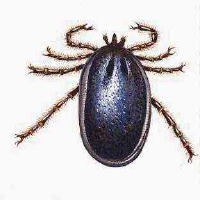 |
The ticksTicks are not insects, but mites. |
It has 8 legs, and in France, there are 2 kinds of ticks:
Wild ticks living in hedges, meadows and forests, and domestic ticks living in kennels, stables and cowsheds.
Ticks develop in 4 stages: egg, nymph, larva and adult.
The last three stages are parasitic and require a blood meal taken from mammals (from the smallest: mice, shrews, to the largest: horses, cattle, humans, dogs, etc.).
The tick's reproductive cycle extends over 2 months or more (up to a year), depending on climatic conditions. To take its meal, the nymph, larva and adult attach themselves to the parasitized animal by its rostrum (a kind of small, hard proboscis that enables it to pierce the skin and pump blood).
The bite is painless, as the tick secretes a local anesthetic. On dogs, the attached tick is discovered by stroking or combing the animal; it looks like a wart. In humans, a small, unusual tumour is discovered during grooming.
There's no ideal way to get rid of a tick, but if it's removed before the 24th hour, the risk of disease transmission is greatly reduced.
In the past, oil, petroleum or ether were used to loosen the tick. These are bad methods, as the tick regurgitates before detaching itself, increasing the risk of disease inoculation.
Using tweezers, pinch the tick at the base of the rostrum and pull gently in the direction of the tick, then disinfect the skin. Most of the time, a part of the rostrum remains attached to the skin, which will later be removed or encysted (which is benign).
Tick bites can be prevented by frequently disinfecting and cleaning the kennel if the dog spends the night there.
You can also use repellent or acaricide products (note that products used for fleas or lice have no effect).
These can be applied directly: aerosol cans, liquids applied to the skin around the neck, or by wearing an acaricide collar (check with your vet).
Diseases transmitted by tick bites are essentially piroplasmosis (very frequent) and other rarer diseases: Lyme disease, ehrlichiosis, hepatozoonosis, etc. These diseases are usually fatal if not treated early on. Initially, all these diseases have common symptoms: fever, loss of appetite, sometimes vomiting. So keep a close eye on the fever, and visit the vet immediately if the temperature rises above 39°. Don't wait for dark urine, diarrhoea or haemorrhaging, as it's often too late at these stages of the disease's evolution.






 English (United Kingdom)
English (United Kingdom)